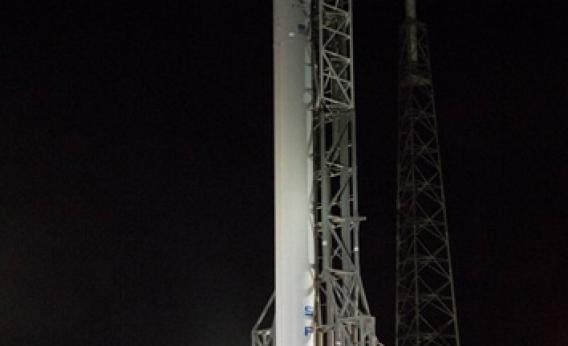Create a free profile to get unlimited access to exclusive videos, sweepstakes, and more!
SpaceX Launch Scheduled for Monday Night

[UPDATE (Nov. 25 at 23:30 UTC): The rocket and spacecraft are safe, but the launch today was scrubbed due to some internal power and tanking issues. SpaceX is investigating, and the next launch window opens up at 22:38 UTC (5:38 p.m.) on Thursday, Nov. 28.]
The private company SpaceX is scheduled to launch a communication satellite into space Monday night at 22:37 UTC (5:37 p.m. EST). It will be webcast live at the SpaceX site.
Although this is an uncrewed flight (no people are onboard), itâs important because this is SpaceXâs first attempt to place a satellite into geosynchronous orbit. Thatâs a special orbit, about 36,000 km (22,000 miles) above the Earthâs surface, where a satellite goes around the Earth once every 24 hours. To the satelliteâs point of view, it always sees the same part of Earth under it, so this is a great place to put weather and communication satellites.
The satellite being launched is a commercial communication sat, called SES-8, and will provide coverage for South Asia and the Asian Pacific regions. Although SpaceX has already launched several payloads to the International Space Station and plans on launching humans in the next few years, satellite deployment missions like this one are important to the company if itâs to compete in the space launch game.
The launch of the Falcon 9 rocket is set for 5:37 p.m. (EST) Monday night. If all goes well, the first stage (with its nine Merlin engines) will thrust for three minutes, then shut down. The second stage will separate and begin firing its single Merlin engineâitâs based on the other engines but designed to work more efficiently in a vacuum. Then the fairing covering the satellite will separate and fall away a minute later. Eight minutes after launch the second stage will stop firing, coasting for 19 minutes. Then it will restart for one minute, putting the satellite into a long, elliptical orbit. Five minutes later the satellite will deploy, separating from the rocket. Over time, on-board thrusters will circularize the satelliteâs orbit, placing it into the planned geosynchronous orbit.
SpaceX had some issues with the second-stage rocket during the last such launch; once it was shut down, it couldnât re-ignite. That problem happened after it had deployed the satellite, but in todayâs case the second stage must re-ignite to put SES-8 into the proper orbit. Ground testing of the second-stage engine since that earlier flight, however, has shown it performing up to speed.
Iâll be watching the launch via the webcast and live-tweeting it as well.


























